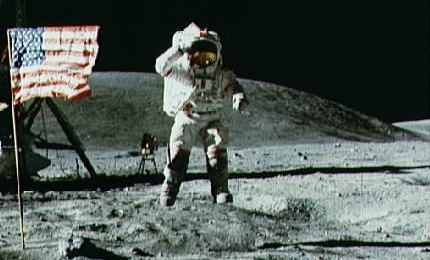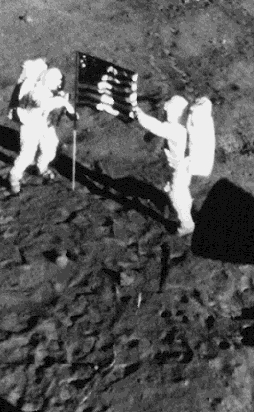 |
Citizen
|
|

There have been SIX manned missions on the Moon. Apollo 11, 12, 14, 15, 16,
and 17. All had extravehicular activity (EVA) on the lunar surface. All Planted
the American Flag on the moon.
Astronaut John Young (Apollo 16) leaping off the lunar surface as he salutes
the American flag. (Photo Courtesy of NASA)
THE LUNAR PLEDGE OF ALLEGIANCE
This works great on camping trips, especially at
the close of a campfire. Other suggested uses are Boy Scouts, Girl Scouts, Church
groups, Military groups, summer camp, or another nighttime activities or ceremonies.
The following reading should take approximately 3 - 5 minutes.
Since we have no flag out here to salute
or retire tonight, we are going to do something called The Lunar Pledge of
Allegiance. This is how it goes.
Would everyone please rise.
Options:
- A prearranged group may begin humming or singing softly "God Bless America,"
- Or,
- Begin playing a tape recording of the song.
On a, historic day in 1969, three great American astronauts, Neil Armstrong (who
is by the way an Eagle Scout), Edwin "Buzz" Aldrin Jr., and Michael Collins took
an unforgettable flight to the moon in a spacecraft called Apollo 11. After entering
lunar orbit, astronauts Aldrin and Armstrong transferred to the lunar module,
appropriately called The Eagle. The Eagle slowly descended to the surface of the
moon, and on July 20 it landed safely. A few hours later Nell Armstrong, in his
bulky suit, descended the ladder, stepped out onto the surface of the moon (the
firs man ever to do so), and said these historic words:
" That's one small step for
a man,
One giant leap for mankind."
He then proceeded to plant an American flag on the moon and that very flag still
stands there today, over 25 years later. It is that great and proud flag that
we salute tonight, the Stars and Stripes. The 13 red and white stripes
symbolizing the 13 colonies that originally constituted the United States. The
50 white stars on a blue ground, one for each state in the Union - states that
our Founding Fathers guaranteed us would be free and independent states. A flag
that is an honored symbol of our nation's unity. A flag that symbolizes the protection,
under the Constitution, of the rights and privileges of all Americans. It means
that we have a duty to serve when needed, and it allows us to speak freely. It
means that government will be of the people by the people, and for the people,
it is a flag that assures us of life, liberty, and the pursuit of happiness. A
flag that allows us to secure the blessings of liberty to ourselves and our prosperity.
A flag that represents freedom for every American, liberty and justice for all.
A flag that means, from sea to shining sea, we are one nation under God.
So don't you trample on Old Glory. Don't you dare burn our flag. Treat
it with the respect it deserves. As citizens, our patriotism - the love, loyalty
and devotion I pledge
allegiance to the flag,
Of the United States ofGod, indivisible,
With liberty and justice for all.
~ ~
~
Copyright @ 1997 by PAL
Publishing House,
341 Maple Lane, Conroe, Texas 77304.
All rights reserved
To print a copy (for your own use) of just
The Lunar Pledge with no graphics and other background information,
click here, then click your browser's print button.
You must hit your browsers "Back" button to return back here.
Where No Flag Has Gone Before:
Political and Technical Aspects of Placing a Flag on the Moon
NASA Contractor Report 188251 #
Written by Anne Platoff - August 1993
 Abstract
Abstract
The flag on the moon represents an important event in vexillological (Study
of Flags ) history. This paper examines the political and technical aspects
of placing a flag on the moon, focusing on the first moon landing. During their
historic extravehicular activity (EVA), the Apollo 11 crew planted the first flag
of the United States on the lunar surface. This flag-raising was strictly a symbolic
activity, as the United Nations Treaty on Outer Space precluded any territorial
claim. Nevertheless, there were domestic and international debates over the appropriateness
of the event. Congress amended the agency's appropriations bill to prevent the
National Aeronautics and Space Administration (NASA) from placing flags of other
nations, or those of international associations, on the moon during missions funded
solely by the United States. Like any activity in space exploration, the Apollo
flag-raising also provided NASA engineers with an interesting technical challenge.
They designed a flagpole with a horizontal bar allowing the flag to "fly" without
the benefit of wind to overcome the effects of the moon's lack of an atmosphere.
Other factors considered in the design were weight, heat resistance, and ease
of assembly by astronauts whose space suits restricted their range of movement
and ability to grasp items. As NASA plans a return to the moon and an expedition
to Mars, we will likely see flags continue to go "where no flag has gone before."
#
Neil Armstrong and "Buzz" Aldrin (Apollo 11) deploy the first U.S. flag on the
moon on 20 July 1969. (Photo Courtesy of NASA- JSC Photograph S69-40308
#
# For more details on placing
the American Flag on the moon.
Check out NASA Contractor Report #188251: - located on the Web at:
http://www-sn.jsc.nasa.gov/explore/Data/Lib/DOCS/EIC045.html
Return to
American Flag Page ~ Citizen
Pin ~ Activity Pins ~
Webelos Opening Page

 Abstract
Abstract